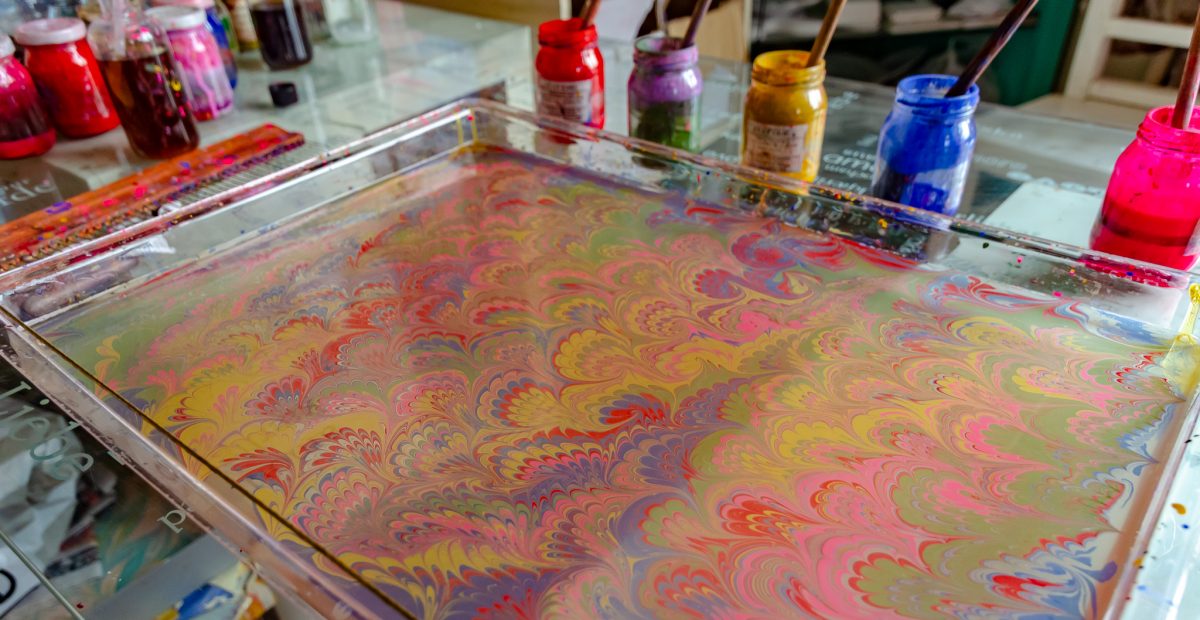Last Updated on 02/19/22 by Rose Palmer
I booked the Turkish paper marbling class online (Like A Local) the day before I was planning to participate. I quickly received a confirmation e-mail with directions to the class location. It was in the Sultanahmet area and not far from my hotel, so it was a brief 3 block walk, and very easy to find.
Learning the Turkish Paper Marbling Process
I met Betoul, the instructor, at her studio, and she took me upstairs to her cozy work space. I learned that Betoul had studied fine arts at University, specializing in traditional tile painting and paper marbling. She has been teaching these crafts to locals and tourists alike for 10 years, so I knew I was in good hands.

Traditional Turkish paper marbling is called Ebru marbling, and Betoul started by describing the equipment, tools and supplies. A solution of Carrageenan, which is a sea weed extract, is mixed with water to form a thickened, gelatinous liquid. A large flat tray is filled with this colorless jello like liquid.
The colors come from pigments which are made from natural oxides in a variety of colors and are made up using cow bile. The cow bile controls the surface tension of the pigments, and allows the pigments to float on the surface of the thickened water and also allows them to be easily manipulated. It also keeps the colors from mixing with each other and helps the pigments to adhere to the paper. Betoul also uses special brushes made of horse hair and rosewood, and a variety of awls and combs to create the desired effect.
Betoul started the class by demonstrating the process. The first step was to use the brush to flick pigments onto the surface of the liquid in the tray. The key was to evenly cover the liquid in the tray with circles of color. This technique was the basis for all other Ebru designs that she showed me and is called Battal.


Once the Battal design was laid down, Betoul used an awl (a long metal pin with a wooden handle) to draw a line up and down the tray. This formed a feather deign which is called a Get Git pattern. She then made another design by moving a large comb over the Gel Git pattern which formed a pattern that she called Tarakli.


She demonstrated how different combs resulted in varied patterns, ending up with a peacock pattern.


When Betoul was satisfied with the final design, she carefully laid a piece of paper on top of the paint, being careful not to disturb the surface, and then gently removed it by pulling it over the edge of the tray. She cleaned the liquid surface with a sheet of news print, and then went on to do another design.


Next, Betoul showed me how to make distinct flower and heart shapes. The paint used in this method is more concentrated and as a result, a drop does not expand as much and the colors are also more intense. Using a thicker awl, she placed a number of drops across the surface, and then added a second and third color into the middle of each circle. Then she used a fine awl to pull the paint in various directions, depending on the shape she wanted to achieve.




Betoul also took some time to tell me about the history of paper marbling, especially in Turkey. This Ebru art emerged in central Asia in what is now Uzbekistan. The Silk Road took it to China, Iran and Anatolia. The art continued to expand and develop in Ottoman Turkey. In the 17th century, Europeans traveling to the Middle East discovered the art and took it back to Europe where it also became very popular.
What makes Turkish Ebru marbling unique is that the technique is also used to make flower shapes, which was the design that Betoul showed me next. She dropped some more paints on to the surface of the liquid, and then very deftly and gently moved the floating pigments with the awl until she had a tulip shape. In the next design, she made a tree with flowers on it. Clearly, the designs were just limited by the imagination.
It was my turn next. Betoul guided me as I repeated each of the different patterns that she had made. I was the only one in the class on that day, so I could take my time to decide on color combinations and play with manipulating the pigments across the surface of the tray. My final products were not master level art, but I liked them.
The best part was that once all the papers dried, I got to keep them and take all these designs home.

I loved my visits to beautiful Istanbul, and any opportunity to learn more of the local culture and history is always a bonus. I really enjoyed this introduction to the art of Ebru, and I went home with a very personal souvenir from my visit to Istanbul. My favorites pieces will get framed and hung in my sewing room (hmmmm………this would be a really cool way to make fabrics for a quilt……….).
Other stories about my visits to Istanbul you may enjoy:
Beautiful Istanbul in photos: A Love Letter to Beautiful Istanbul
What a Turkish bath is really like: Bathing Like a Sultan – Overcoming Naked Inhibitions in a Turkish Bath in Istanbul
Discover the best street art in Istanbul: Finding Cool Street Art in Istanbul
A visit to the Topkapi Palace Harem: Sleeping With the Sultan – Behind the Walls of Istanbul’s Topkapi Palace Harem
Visit the historic mosques of Istanbul: Visiting the Historic and Famous Mosques in Istanbul
Thanks for visiting.
Rose
Pin this!








